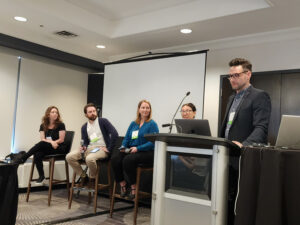Key learnings from the 7th Annual Marketing and Communications for Post-secondary Conference
By Sharon Aschaiek and Ruba Hassan | June 7, 2023

When it comes to understanding the unique trends and issues facing marcomm professionals in the higher education sector, few conferences are as on point as the Marketing and Communications for Post Secondary Conference.
The 7th edition of this annual conference took place late last month in Toronto, and I had the privilege to serve as chair for the second time. The two-day event featured presenters from Canadian universities and colleges sharing about the marcomm strategies and tactics they use to help their units and institutions at large achieve their strategic goals.
From the University of Toronto, we learned about how the institution has adapted its social media practices in light of the decline of Twitter, after new CEO Elon Musk made significant changes that caused many to leave the platform. Sharing their input were Krista Boniface of U of T Communications, Haley Overland of Student Life, Shauna Rempel of U of T Mississauga and Steven Southon of the Leslie Dan Faculty of Pharmacy, with director of digital content and engagement Chris Boutet serving as moderator.

All of the panelists noted the parallel on Twitter between the decrease in staff and the rise in hate—resulting in them having to spend more time monitoring and dealing with hateful comments. Rempel described how UTM has been concentrating more of its social media efforts on Instagram and FB, where the campus has high engagement, and has also been exploring Mastodon. Southon shared about the pharmacy faculty’s foray into podcasting with “I’m Pharmacy,” which is geared to students, researchers and scientists, and has generated buzz and community interest.
Central communications, Boniface said, has been focusing more on YouTube, producing short videos that are striking a chord on Instagram but not as much on Twitter. Boutet mentioned being invited to test out the beta version of Bluesky, the new social platform being developed by former Twitter CEO Jack Dorsey, and is optimistic about its potential.
Also presenting at the conference was Ryan Kelly, alumni coordinator of engagement in External Relations at Sheridan College. He shared about his approach to creating content for alumni that has different purposes–to entertain, inspire, educate and/or convenience. He noted that “strong content has the ability to deliver the right message to the right audience at the right time.”

Kelly likes to strike a balance between posting content spontaneously (when it makes sense) and planning carefully curated content. Though he cautioned against “chasing the shiny ball” with content creation–meaning seizing on viral moments or platforms, which may or may not be relevant to your alumni audience.
He is also a fan of what he called “content farming” – identifying and saving suitable content ideas that he can plant in his social media lineup. He prioritizes being agile with his social media approach, and advised audience members to evaluate their plans often and change course if needed. Social media platforms move fast. “Don’t be afraid to change things up if your content is not delivering the metrics you expected.”
Presenters from the Toronto Metropolitan University discussed one of the biggest Canadian higher ed marcomm stories in recent years, the renaming of what was formerly Ryerson University to TMU. Karen Benner, associate director of university communications, and Derek Flack, assistant director of content strategy, shared their input.

Flack explained that the decision to change the institution’s name required using unique marketing tactics to reach TMU’s main stakeholders. To connect with students, TMU relied on vertical video. He said that Instagram and TikTok were crucial in engaging students and meeting them where they were. He also noted that alumni were the toughest stakeholder group to get on board with the change. The university had to convince this group that their degrees and memories at TMU were still valuable. He said that the university engaged alumni through multiple vehicles, from personal phone calls to a dedicated social media campaign.
When it was time for the launch, Benner shared that the school chose to give an exclusive interview to the Globe and Mail. She explained that this was done to avoid misinformation. In fact, she found that the public viewed the story as more factual, as it came from a reputable media publication rather than a school announcement.
Benner and Flack’s teams knew they couldn’t persuade everyone that changing the school’s name was the right move. Therefore, through diverse tactics, they decided to focus on their advocates and the “mushy middle” who could be convinced down the line.
Another engaging session from the University of Toronto looked at building trust and collaboration in a tri-campus university structure. Jane Stirling, executive director of marketing and communications at U of T Mississauga, and Julia Oosterman, executive director of marketing and communications at U of T Scarborough, along with Catherine Riddell, assistant vice president of U of T Communications, used case studies to demonstrate how U of T’s three campuses engage in collaborative communications.

Stirling described how consolidating the different campus’s alumni magazines into one University of Toronto magazine was one of the major projects the campuses undertook to move towards equitable and intentional collaboration. Not only was this move cost-effective, but it also ensured better brand consistency. “We are not satellites, we are full partners,” said Stirling. In this spirit, the magazine represents full collaboration by giving up local control in favour of one publication that is “tri-campus in content and tone,” she explained.
Another project shared by Riddell was the innovative tri-campus production Joe’s Basketball Diaries. This successful web series airing on U of T’s YouTube channel features guests from the school and beyond discussing topics such as racism, mental health and women in sports. Riddell explained that this project owes its success to effective collaboration and commitment to work towards a shared purpose.
These projects were made possible with the power of vulnerability and trust, said Oosterman, who is a big believer in leaning into humanity and having the courage to be vulnerable to build strong and lasting partnerships. She encouraged communicators to stay away from a silos mentality and to find shared goals with their peers. She stressed that we should focus on being collaborators and not “kingdom builders” in our institutions.
The conference also featured presentations by marcomm leaders from U of T’s Schwartz Reisman Institute for Technology and Society and from Lakehead University, as well as from executives at marcomm firms.